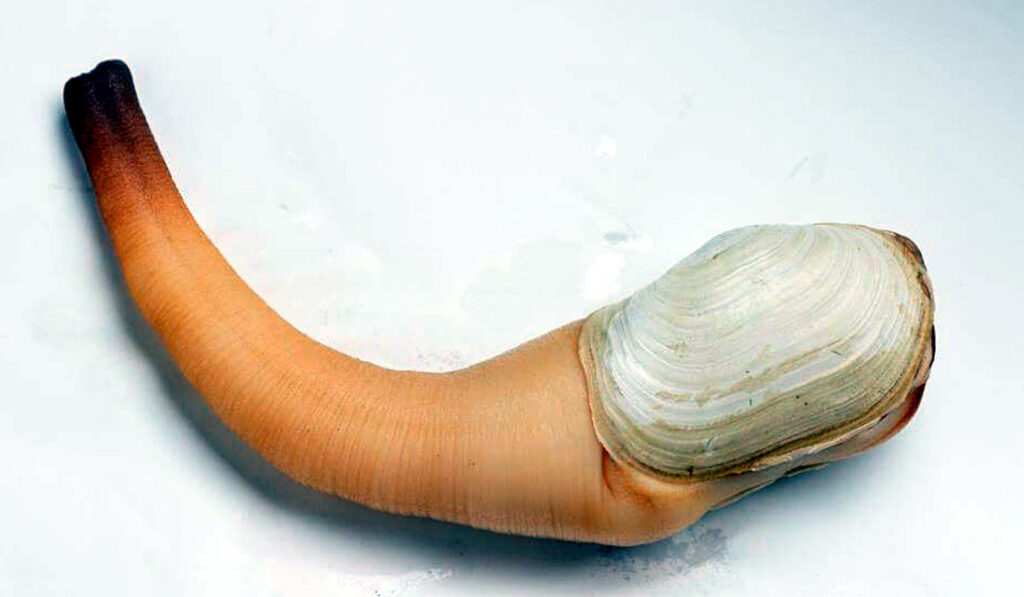A strange-looking mollusk with a long neck, Geoduck is one of the most popular and tasty clams in the Pacific Northwest. It’s also a delicacy in Asia.
As a food source, geoduck is rich in protein and omega-3 fatty acids. These nutrients promote heart health, relieve stress, and reduce blood lipids.
Overview of eating Geoduck
Geoduck, pronounced gooey-duck, is a clam that’s gaining popularity in the US as a cult favorite. It’s an unusual seafood that has a long, leathery neck that looks like an elephant trunk or a prehistoric earthworm emerging from a fist-sized shell.
The neck splits open into two sections: one for taking in oxygen and nutrients, the other for releasing excess water. Its siphon is also long and its body can grow to a length of multiple feet.
The clam is native to the Pacific Northwest, and is grown both wild and in aquaculture. Despite their bizarre appearance, they are a highly profitable food source. Exports to China and Hong Kong account for more than 90% of harvested geoducks.
Culinary uses and traditional dishes
The geoduck, or gweduc in Lushootseed, is a large burrowing bivalve clam native to the Pacific Northwest and western Canada. It has a long soft neck or siphon that hangs from its shell.
The clam spends its entire life attached to this spot on the seafloor, sucking in water and filtering it for small particles of food. It also filters excess water from the surrounding sea.
In North America, geoduck is most commonly eaten in the Pacific Northwest, where it is a staple ingredient in ceviche, chowder, and even savory pie (Art of the Pie). It’s also popular in Asia, where it’s served raw with hot chili sauce or in soups and stir-fries.
Availability and market trends
Geoduck is one of the most popular native mollusks in Puget Sound. It is also a highly prized shellfish in China, which eats it for sashimi, sushi, and even in soups and stir-fries.
The Northwest Coastal region supplies half the world’s geoduck supply, as companies grow it on beaches and divers harvest it from underwater tracts. But geoduck is also a target of thieves and poachers.
Wildlife authorities have stepped up undercover investigations, spying on thieves from boats and using underwater cameras to document thefts. The clam’s popularity has also grown in Asia, where it is now known as mirugai (“giant clam”) in Japan and enjoyed as a hot pot in China.
Health benefits and concerns
Geoducks are large, saltwater clams with double-barreled necks called siphons. They use their siphons to eat phytoplankton, which are microscopic organisms that provide geoducks with essential nutrients.
The siphons also filter water, preventing contaminants from entering the body and allowing the clam to grow larger. When predators approach, the clam retracts its siphon to avoid injury (Smithsonian).
Some shellfish, such as geoduck clams, can retain and accumulate toxin in their tissue, a condition known as paralytic shellfish poisoning. This can cause illness or even death when consumed in high concentrations.
In the Pacific Northwest, geoduck clams are commonly used in ceviche and sushi, as well as seafood dishes such as chowder or savory pie. They are also a popular delicacy in Japan.
Sustainability
The Geoduck fishery has been managed for over 30 years using a precautionary approach to ensure that the Department meets its conservation goals and maintains sustainable stocks of this marine invertebrate. It has been co-managed by the Underwater Harvesters Association and the Department through a variety of input and output control measures including effort regulation, seasonal closures, individual vessel quota and rotational fisheries.
The wild harvest is a key part of the fishery’s sustainability strategy and is based on a stock assessment study by the Underwater Harvesters Association in collaboration with the Department. The Department is completing on-going scientific research and stock assessment surveys to improve knowledge of the resource, its biological characteristics and its impacts.

